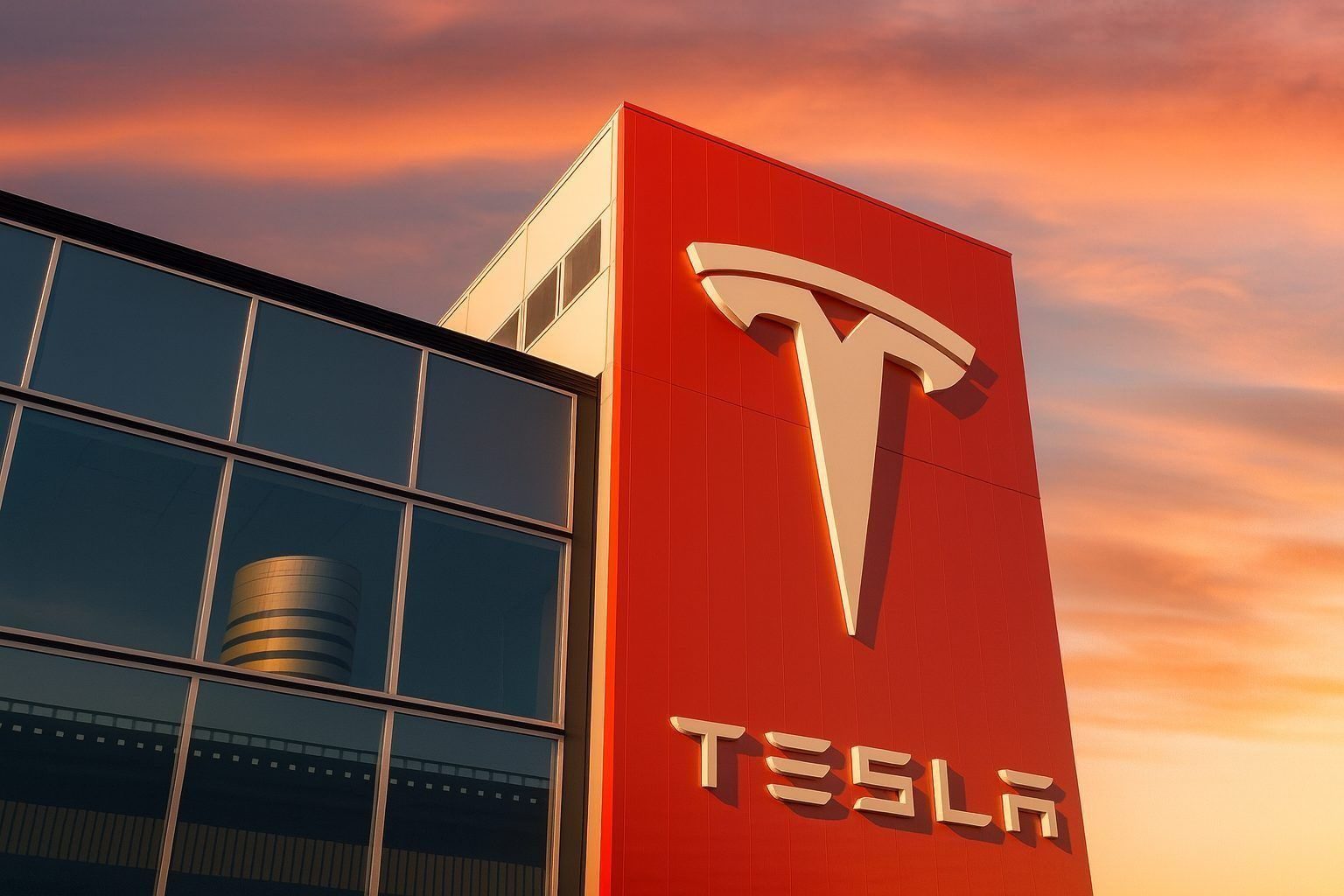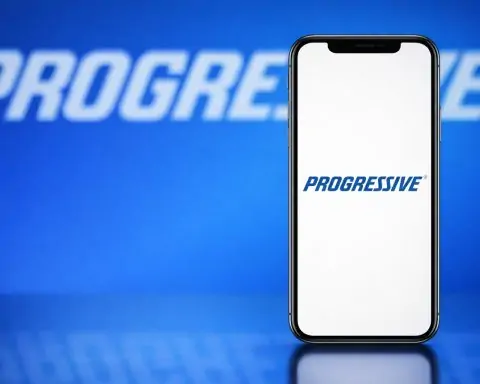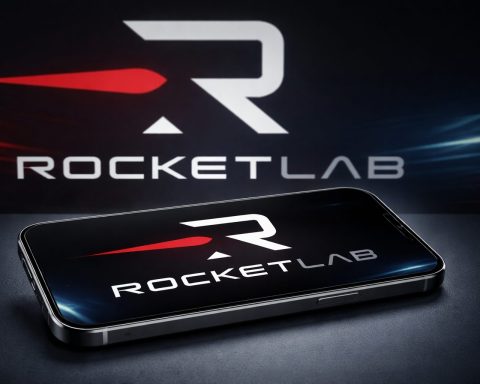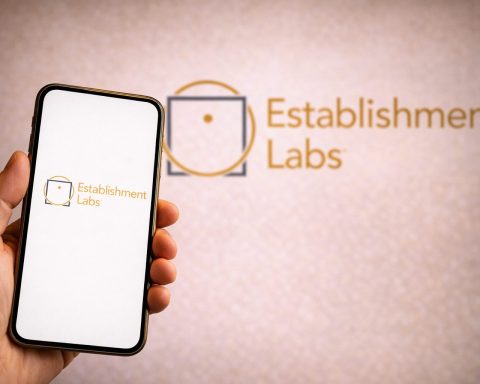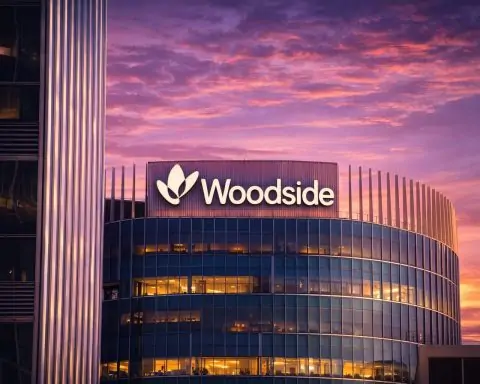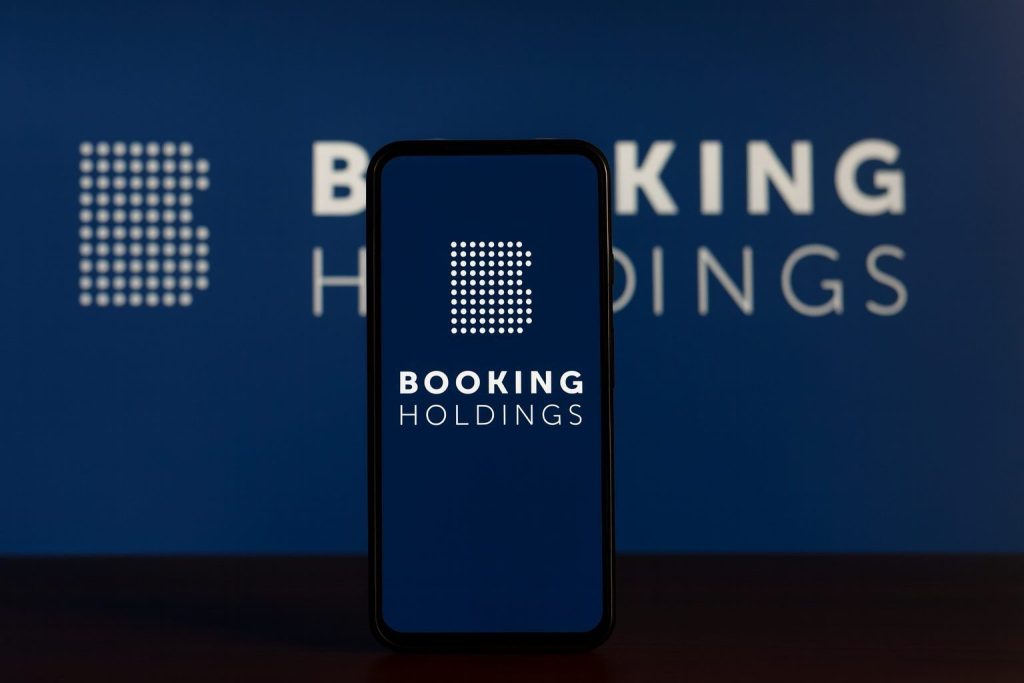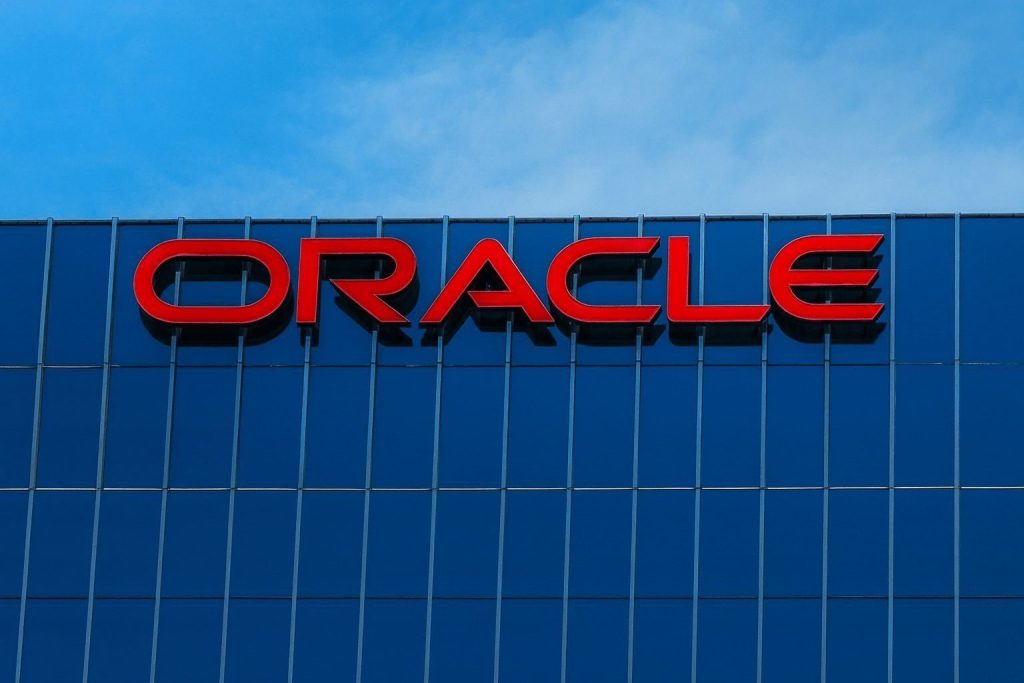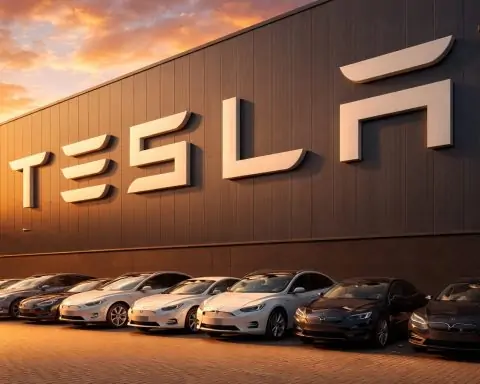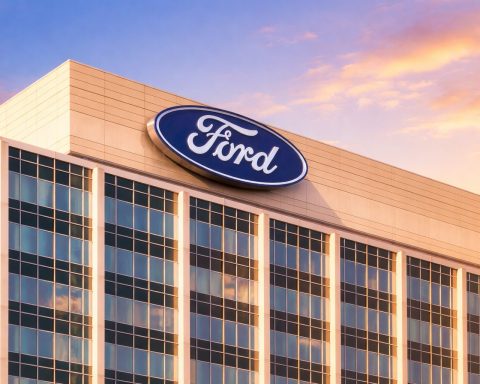Record deliveries, falling profits, aggressive autonomy bets and a $1 trillion CEO pay package are pulling Tesla in different directions at once.
A company in transition
Tesla (TSLA) heads into the end of 2025 looking more like a tech conglomerate in mid‑pivot than a straightforward electric‑car maker.
On the one hand, the company just reported record quarterly vehicle deliveries of about 497,000 units in Q3 2025, up 7% year‑on‑year, with total revenue rising 12% to $28.1 billion and automotive revenue hitting $21.2 billion. [1]
On the other hand, its operating profit fell roughly 40% to $1.6 billion, as margins were squeezed by price cuts, higher costs and weaker software revenue from its Full Self‑Driving (FSD) option. [2]
At the same time, fresh data show that global Tesla deliveries are projected to decline about 7% in 2025, following a 1% drop in 2024, even as the broader EV market continues to grow. [3]
That tension — between record shipments and shrinking momentum — underpins almost every major story around Tesla right now: regulatory scrutiny of FSD, a new free‑trial push, a deepening sales slump in Europe and China, rapid growth in grid batteries, the humanoid Optimus robot, and a controversial new $1 trillion pay package for CEO Elon Musk.
Full Self‑Driving v14: free trials and regulatory gambits
30‑day FSD v14.2 trial across North America
Tesla’s biggest near‑term news is its 30‑day free trial of Full Self‑Driving (Supervised) v14.2 for eligible owners across North America.
- The trial is available to owners of Model S, 3, X, Y and Cybertruck equipped with the latest Hardware 4 (also called AI4) computers. [4]
- Tesla’s own support page touts features such as Speed Profiles (ranging from conservative to aggressive settings like “Mad Max”) and new Arrival Options that let drivers choose where the car should park at the destination. [5]
- Third‑party trackers cited by Investors Business Daily estimate that FSD v14 can now go thousands of miles between “critical disengagements”, a huge jump over v13, though still nowhere near fully autonomous performance. [6]
Analysts see the free trial as part product confidence, part marketing. Tesla has run FSD trials before without a big subscription spike, but the company is betting that a visibly better v14 — delivered to roughly 1.5 million hardware‑4 vehicles according to independent estimates — will convert more drivers into paying customers. [7]
Robotaxis in Austin, the Bay Area – and soon more cities
FSD v14 is also the software brain behind Tesla’s nascent robotaxi service:
- Tesla launched an invite‑only robotaxi program in Austin, Texas, in June 2025, using a small fleet of Model Y vehicles in a geofenced area of South Austin. Rides run from 6am to midnight and currently include a Tesla employee “safety monitor” in the front passenger seat. [8]
- A Q3 update confirmed that Tesla has expanded the Austin service and launched a ride‑hailing service in the San Francisco Bay Area, using real‑world data to refine its universal robotaxi model before scaling to other cities. [9]
- In late November, Elon Musk said the robotaxi fleet in Austin should “roughly double” in December, and that Tesla has received a permit to operate a ride‑hailing service in Arizona. [10]
Despite these moves, all Tesla robotaxis still require human safety monitors, and regulators have not yet allowed driverless operation.
The European FSD campaign: ride‑alongs and a skeptical regulator
Tesla’s other big autonomy push is happening in Europe:
- The company is rolling out FSD ride‑along events in France, Germany and Italy, letting passengers experience the system from the front seat while a Tesla staff member supervises. [11]
- Tesla has told customers it expects FSD to gain Netherlands national approval from Dutch regulator RDW in February, a key step because other EU states could then quickly recognize the system. [12]
- RDW publicly pushed back, stressing that it has not promised approval and that sign‑off will only come if Tesla can convincingly prove the system’s safety. The regulator even asked Tesla fans to stop emailing and calling after the company encouraged customers to “thank” RDW and lobby in favor of FSD. [13]
Musk has also said he expects FSD to be approved in China early next year, which would give Tesla a high‑profile autonomy beachhead in the world’s largest EV market. [14]
Under the hood: Tesla’s AI supercomputer and FSD v14
Tesla’s latest investor presentation shows just how much the autonomy bet now shapes the entire company:
- The company has begun rolling out FSD v14 to retail owners, describing it as a consumer‑facing version of its robotaxi stack with better handling of complex scenarios, including avoiding road debris, yielding to emergency vehicles and fine‑grained arrival options for parking. [15]
- Tesla says its in‑house AI training cluster, “Cortex,” has grown to around 81,000 Nvidia H100‑equivalent GPUs, boosted by a new chip manufacturing deal with Samsung for AI inference and training semiconductors. [16]
The strategic message is clear: Tesla wants investors to see it as a real‑world AI company that happens to build cars, rather than a car company that happens to ship software.
Safety probes and recalls: autonomy meets regulation
The FSD and robotaxi push is unfolding under unprecedented regulatory scrutiny.
New NHTSA investigation into FSD traffic violations
In October, the U.S. National Highway Traffic Safety Administration opened a major investigation into about 2.88 million Tesla vehicles equipped with FSD after receiving 58 reports of traffic‑safety violations, including 14 crashes and 23 injuries. [17]
According to NHTSA:
- FSD has in some cases driven through red lights or into oncoming lanes during lane changes, behavior that explicitly violates traffic laws. [18]
- At least six crashes involved Teslas entering intersections on red and colliding with other vehicles. [19]
The investigation is still in a preliminary phase but could lead to another large‑scale recall if regulators decide FSD poses an “unreasonable risk to safety.”
Other U.S. safety probes and the “Mad Max” debate
The FSD inquiry is only one piece of a broader regulatory puzzle:
- NHTSA is separately investigating 2.6 million Teslas over a “remote movement” feature that lets owners move vehicles using a phone app, following reports of crashes in parking lots and driveways. [20]
- Regulators have also raised concerns about FSD’s aggressive “Mad Max” speed profile, which some users report allows the car to exceed posted limits by a wide margin; U.S. senators have urged closer review. [21]
Tesla emphasizes that FSD remains a driver‑assistance feature that requires active supervision and does not make vehicles autonomous, a disclaimer repeated in its own documentation and investor materials. [22]
A long list of recalls, from cameras to Cybertruck lights
While software updates can fix many issues over the air, Tesla has had to launch a notable series of recalls in 2024–25:
- In January, Tesla recalled about 239,000 vehicles — including recent Model 3, S, X and Y — after discovering that rear‑view camera displays could fail due to short circuits in the on‑board computer. Tesla addressed the issue with a software update and, where necessary, replacements of the affected computers. [23]
- In December 2024, Tesla recalled roughly 694,000 vehicles in the U.S. over a tire‑pressure monitoring glitch that could fail to warn drivers about dangerously low tire pressure, again resolved via software. [24]
- In China, regulators ordered Tesla to recall around 1.2 million vehicles over rear‑view camera and steering issues, with fixes delivered through free updates. [25]
- Most recently, Tesla recalled more than 63,000 Cybertrucks in the U.S. because their headlights were too bright and could dazzle other drivers. A separate Cybertruck recall earlier in 2025 covered about 46,000 vehicles over an accelerator‑pedal issue. [26]
None of these recalls has seriously dented Tesla’s balance sheet so far, but they provide an important backdrop as regulators consider whether to allow wider deployment of FSD and robotaxis.
Sales slump in Europe, China and the United States
If autonomy is Tesla’s dream, sliding vehicle sales are the headache that won’t go away.
Europe: from market leader to laggard
The steepest drop is in Europe:
- Tesla’s European sales fell 48.5% year‑on‑year in October, according to the European Automobile Manufacturers’ Association, even as EV sales across the region grew 26%. Year‑to‑date, Tesla volumes are down about 30% in Europe. [27]
- China’s BYD now sells more than twice as many cars as Tesla in Europe, while Volkswagen’s EV sales have surged to over 520,000 units through September — roughly triple Tesla’s volume. [28]
- Analysts say Tesla is increasingly squeezed between cheap Chinese imports and refreshed European models, while still relying on just two mass‑market vehicles in the region: the Model 3 and Model Y. [29]
The decline also follows a wave of boycott calls and protests in several EU countries after Musk publicly praised far‑right politicians in late 2024, damaging Tesla’s brand among some buyers. [30]
China: intense competition and falling share
In China, Tesla remains a significant player but is losing ground:
- Tesla’s deliveries fell 35.8% year‑on‑year in October, hitting a three‑year low, and were down about 8.4% for the year through October. [31]
- The company faces a flood of new models and price cuts from domestic rivals including BYD, Chery and smartphone‑maker‑turned‑EV‑brand Xiaomi, whose YU7 crossover has quickly become a direct Model Y rival. [32]
Tesla has responded with cheaper “Standard” versions of the Model 3 and Model Y and localized variants like the longer‑wheelbase Model YL in China, but competition is intensifying faster than Tesla’s product cadence. [33]
United States: tax‑credit whiplash
The U.S. picture is more mixed:
- Research firm Motor Intelligence estimates that Tesla’s U.S. sales jumped 18% in September as buyers rushed to lock in a $7,500 federal EV tax credit before it expired on September 30 — only to drop 24% in October once the credit vanished. [34]
- Tesla’s Q3 surge in deliveries was heavily influenced by that pull‑forward demand, a fact noted in multiple earnings analyses. [35]
Even so, cheaper Model 3 and Model Y trims introduced in the U.S. in Q3 — some with prices cut by around $5,000 — should help Tesla defend share as other automakers scale back some planned EV launches. [36]
Energy storage and Supercharging: the quiet growth engine
While the auto business dominates headlines, Tesla’s energy and services divisions are quietly becoming more important.
Record energy storage deployments and profit
In Q3 2025:
- Tesla deployed around 12.5 GWh of stationary energy storage, up 81% year‑on‑year.
- Energy storage revenue rose 44% to about $3.4 billion, and segment gross profit hit a record $1.1 billion. [37]
The company attributes the growth to ramp‑ups at its Megafactory in Shanghai and strong demand for both utility‑scale Megapacks and residential Powerwalls. [38]
Megapack 3 and Megablock: 20 MWh in a box
At the RE+ renewable energy conference in Las Vegas in September, Tesla unveiled Megapack 3 and an integrated system called Megablock:
- Megapack 3 increases per‑unit capacity to roughly 5 MWh, up from 3.9 MWh in the prior generation. [39]
- A Megablock combines four Megapack 3 units with a transformer and switchgear, delivering about 20 MWh of grid‑connected storage in a pre‑engineered package rated for a 25‑year life and over 10,000 cycles at about 91% round‑trip efficiency. [40]
- Tesla plans to begin Megapack 3 production at a Houston Megafactory in 2026 with up to 50 GWh of annual capacity. [41]
Tesla is also piloting a solar‑plus‑Powerwall lease in the U.S. that aims to offer predictable monthly energy costs and system uptime guarantees, signalling an increasing focus on recurring service revenue from the energy side. [42]
Meanwhile, its Supercharger network continues to grow; Tesla says it added over 3,500 net new stalls in Q3, and has begun rolling out V4 Superchargers capable of up to 500 kW for passenger cars and 1,200 kW for the Tesla Semi. [43]
Optimus and Musk’s $1 trillion pay package
Optimus: from prototype line to “million‑unit” ambition
Tesla’s November shareholder meeting in Austin gave the clearest view yet of its humanoid robot, Optimus:
- The company showed video of a prototype production line at its Fremont factory assembling Optimus units, described by Tesla’s AI lead Julian Ibarz as an R&D line rather than the final scaled manufacturing system. [44]
- Ibarz said a “completely different” high‑volume line is planned for 2026, and Musk reiterated that Tesla is targeting about $20,000 cost of goods per robot at scale. [45]
- Musk has repeatedly floated a future where Tesla deploys millions of Optimus units in factories, logistics centers and even service roles, arguing that the robot business could ultimately be worth more than the car business. [46]
The $1 trillion CEO pay plan
Against this backdrop, Tesla shareholders in early November approved an unprecedented pay package for Elon Musk worth up to $1 trillion over roughly a decade, contingent on hitting extremely ambitious operational and valuation milestones. [47]
Key features include:
- Targets for Tesla’s market capitalization to reach as high as $8.5 trillion, with Musk able to earn up to roughly $878 billion after accounting for certain deductions. [48]
- Operational milestones such as 20 million vehicle deliveries per year, 1 million robotaxis deployed and 1 million Optimus robots sold, aligning Musk’s incentives with the autonomy and robotics road map. [49]
- The potential to lift Musk’s ownership stake in Tesla to around 25% if all tranches vest. [50]
Supporters argue that tying Musk’s rewards to extreme performance outcomes is a rational way to retain a uniquely aggressive CEO in a global talent market. Critics — including Norway’s sovereign wealth fund, which voted against the plan — see it as excessively dilutive, risky and misaligned with Tesla’s current struggles in core auto markets. [51]
What it all means for Tesla and TSLA going into 2026
Stepping back from the daily news flow, Tesla’s situation at the end of 2025 can be boiled down to a few central tensions:
- Growth vs. profitability
The company can still post record deliveries and revenue, but only by discounting cars and leaning on tax‑credit deadlines, which has driven multi‑quarter declines in operating margins and net income. [52] - Hardware vs. software & services
Tesla insists that long‑term profits will come from AI, software and fleet‑based services layered on top of its installed base of vehicles and batteries. That vision depends heavily on successful, safe deployment of FSD, robotaxis and Optimus — all of which currently generate more hype than revenue. [53] - Regulation vs. speed
In autonomy, Tesla’s instinct is to move fast and expand trials, while regulators in the U.S., Europe and China are accelerating their own reviews and probes. FSD v14’s free trial and the European ride‑along campaign are happening alongside NHTSA’s 2.88‑million‑vehicle investigation and RDW’s insistence that approval is far from guaranteed. [54] - Cars vs. everything else
The EV pioneer now finds its car lineup relatively old and its sales shrinking in its three biggest markets, just as competitors roll out dozens of new models. Yet Tesla is devoting increasing airtime — and a huge CEO incentive plan — to robotaxis, robots and grid batteries rather than new mass‑market vehicles. [55]
For investors, regulators, customers and competitors, 2026 is likely to hinge on a handful of questions:
- Can Tesla stabilize or grow global vehicle sales without sacrificing margins even further?
- Will NHTSA’s FSD probe and other investigations end in additional recalls or hard limits on Tesla’s autonomy features?
- Can the company win regulatory approval for FSD in Europe and China on a timetable that supports Musk’s robotaxi ambitions?
- And will the rapidly scaling energy storage and Optimus businesses prove to be the powerful second and third engines that Tesla’s new pay plan assumes?
Tesla has spent the past decade teaching the auto industry to take electric vehicles seriously. The next decade will test whether the company can do the same for robotaxis, humanoid robots and AI‑driven energy networks — while still selling enough cars to keep the lights on.
References
1. www.wardsauto.com, 2. www.wardsauto.com, 3. www.reuters.com, 4. www.investors.com, 5. www.tesla.com, 6. www.investors.com, 7. driveteslacanada.ca, 8. en.wikipedia.org, 9. assets-ir.tesla.com, 10. www.reuters.com, 11. www.businessinsider.com, 12. www.reuters.com, 13. www.reuters.com, 14. www.reuters.com, 15. assets-ir.tesla.com, 16. assets-ir.tesla.com, 17. www.reuters.com, 18. www.reuters.com, 19. www.reuters.com, 20. apnews.com, 21. www.theguardian.com, 22. assets-ir.tesla.com, 23. www.tesla.com, 24. people.com, 25. www.wsj.com, 26. apnews.com, 27. www.reuters.com, 28. www.reuters.com, 29. www.reuters.com, 30. www.reuters.com, 31. www.reuters.com, 32. www.reuters.com, 33. assets-ir.tesla.com, 34. www.reuters.com, 35. www.wardsauto.com, 36. www.wardsauto.com, 37. www.wardsauto.com, 38. assets-ir.tesla.com, 39. pv-magazine-usa.com, 40. pv-magazine-usa.com, 41. assets-ir.tesla.com, 42. assets-ir.tesla.com, 43. assets-ir.tesla.com, 44. www.humanoidsdaily.com, 45. www.humanoidsdaily.com, 46. www.humanoidsdaily.com, 47. www.reuters.com, 48. www.reuters.com, 49. www.reuters.com, 50. www.latimes.com, 51. apnews.com, 52. www.wardsauto.com, 53. assets-ir.tesla.com, 54. www.reuters.com, 55. www.reuters.com
